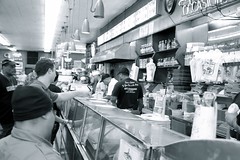 Nelso.com has been working on-and-off over the last six months integrating Twitter business accounts with our core local search site. We've collected a large data set, and we thought it might be interesting to do some analysis of this data to see how small businesses are really using Twitter. We've not seen these kind of concrete numbers elsewhere, so our readers might find them useful.
Nelso.com has been working on-and-off over the last six months integrating Twitter business accounts with our core local search site. We've collected a large data set, and we thought it might be interesting to do some analysis of this data to see how small businesses are really using Twitter. We've not seen these kind of concrete numbers elsewhere, so our readers might find them useful.About the Data Set
The data set we analyzed consists of our database of more than 2,000 businesses in the United States using Twitter (we have data for countries other than the U.S., but our U.S. data set is the most comprehensive).
Because Nelso.com is a local search site, these are all businesses that are included in Nelso's regular local search listings. They are businesses that one might actually visit - always with a physical address, and most open to the public. There are no home-based "Get 1000s of Twitter followers every day!" "business" accounts in this data set. Although there are some major multinationals in the data set (e.g. @Starbucks, @dominos), over 90% of the businesses included are single-location, independently-owned entities. Every one of these business accounts was reviewed by hand to make sure it was suitable for a local search site.
The businesses are located in small towns and major cities, from Anchorage, Alaska to Key West, Florida and everywhere in between. They represent more than 100 business categories, from restaurants and bars to dentists, plumbers, and bookstores.
We are using the word "business" in this post, but not all the entities in the data set are for-profit businesses. We've also included museums, government agencies, zoos, and other not-for-profit entities in the data set. Although these are not strictly "businesses", we didn't see the point in, for example, excluding the San Diego Zoo because it's not a for-profit business. The goal of the San Diego Zoo using Twitter is the same as any for-profit business - to promote its products and services, and to (hopefully) engage in dialogue with past and future customers.
Although we can't prove that this data set is truly representative of all businesses using Twitter in the United States, the size of data set, the geographical distribution, and the large number of business types gives us confidence in our conclusions.
Of course, you're free to search the entire database at tweet.nelso.com. If you are more visually oriented, you can see the entire data set on this interactive map.
Level of Activity and Abandoned Accounts
First the bad news. As you can see in the chart below, a significant portion (18%) of businesses have not posted an update to their account for the last 30 days. 28% have not updated in more than 14 days, and 37% have not made an update in the last week. As some of the "no post in the last 14 days" accounts are not even a month old, we think it's safe to say that at least 20% of all business accounts in our sample set have been abandoned.
However, if we take out the accounts that have likely been abandoned, we see that many businesses are using Twitter quite actively. Again, taking out the "no activity" accounts, more than 50% of the remaining accounts are updating at least once a day, and 18% of all business accounts are updating more than twice a day (see this list of very active Twitter business accounts). The average number of updates (tweets) per month for a business account on Twitter is 32.6.
Engaging the Audience
Although it's impossible for us to review every business account and attach a score to their use of Twitter as a communication tool (rather than purely as a way to broadcast messages), we can run a couple of simple tests.
Of all the tweets by U.S. businesses over the last 30 days:
- 19.6% were a direct reply to another Twitter user (i.e. started with '@')
- 51.6% were either a reply to another user, or included a reference to another Twitter user (using the '@example' syntax)
- 33% of all tweets by businesses contain a link
Followers
So we've determined that most businesses "get" how Twitter works. How large is their potential audience (i.e. how many followers does a business account have)? While the average Twitter business account has 2526 followers, this is deceptive because of the presence of a few "mega accounts". The median number of followers for an account is 446. That is, more than half of all Twitter business accounts have fewer than 500 followers.
Having too few followers is highly correlated with abandoning an account - a quick perusal of likely abandoned accounts indicates that a business needs at least 100 followers to remain active on Twitter.
Update: Ran some numbers to confirm the above statement. Wasn't too far off. The median number of followers of a Twitter business account that hasn't updated in the last 30 days is 224, while the median number of followers of an account that has updated in the last 30 days is 542.
If you have any questions or comments, or have an idea for additional analysis we could do on our data set, use the comments section below.








